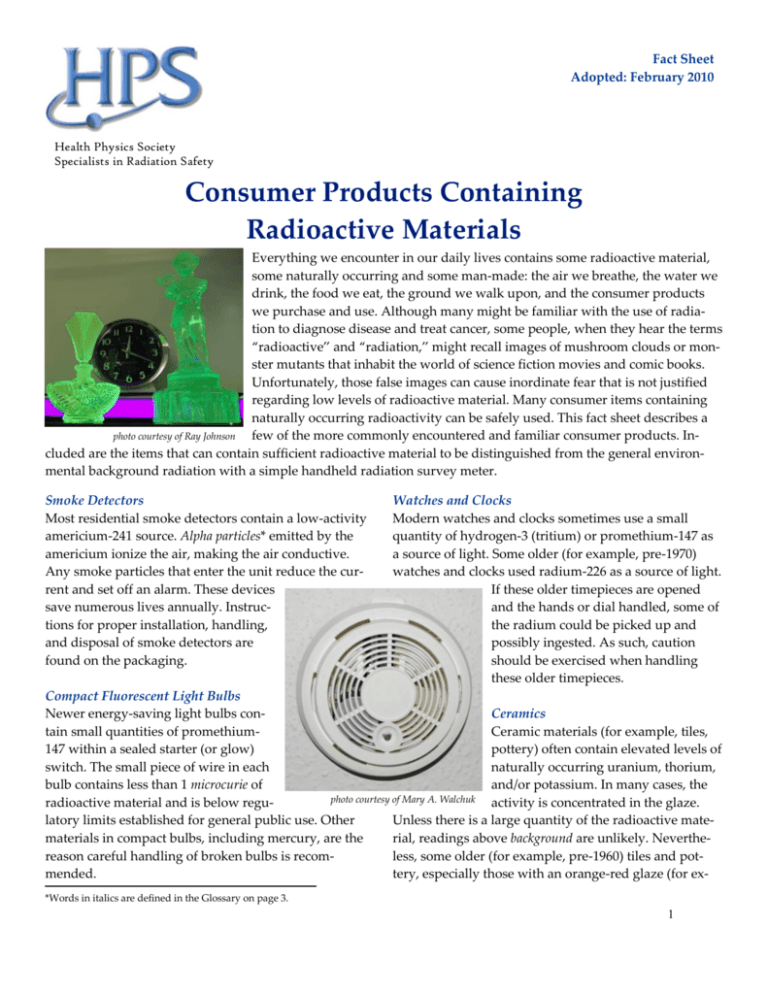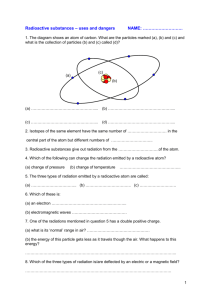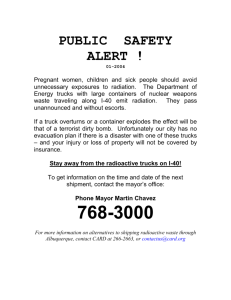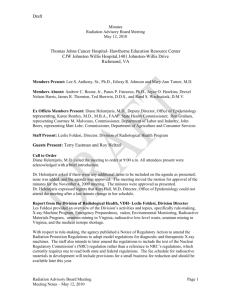Consumer Products Fact Sheet
advertisement

Fact Sheet Adopted: February 2010 Health Physics Society Specialists in Radiation Safety Consumer Products Containing Radioactive Materials Everything we encounter in our daily lives contains some radioactive material, some naturally occurring and some man-made: the air we breathe, the water we drink, the food we eat, the ground we walk upon, and the consumer products we purchase and use. Although many might be familiar with the use of radiation to diagnose disease and treat cancer, some people, when they hear the terms “radioactive” and “radiation,” might recall images of mushroom clouds or monster mutants that inhabit the world of science fiction movies and comic books. Unfortunately, those false images can cause inordinate fear that is not justified regarding low levels of radioactive material. Many consumer items containing naturally occurring radioactivity can be safely used. This fact sheet describes a photo courtesy of Ray Johnson few of the more commonly encountered and familiar consumer products. Included are the items that can contain sufficient radioactive material to be distinguished from the general environmental background radiation with a simple handheld radiation survey meter. Smoke Detectors Most residential smoke detectors contain a low-activity americium-241 source. Alpha particles* emitted by the americium ionize the air, making the air conductive. Any smoke particles that enter the unit reduce the current and set off an alarm. These devices save numerous lives annually. Instructions for proper installation, handling, and disposal of smoke detectors are found on the packaging. Watches and Clocks Modern watches and clocks sometimes use a small quantity of hydrogen-3 (tritium) or promethium-147 as a source of light. Some older (for example, pre-1970) watches and clocks used radium-226 as a source of light. If these older timepieces are opened and the hands or dial handled, some of the radium could be picked up and possibly ingested. As such, caution should be exercised when handling these older timepieces. Compact Fluorescent Light Bulbs Newer energy-saving light bulbs conCeramics tain small quantities of promethiumCeramic materials (for example, tiles, 147 within a sealed starter (or glow) pottery) often contain elevated levels of switch. The small piece of wire in each naturally occurring uranium, thorium, bulb contains less than 1 microcurie of and/or potassium. In many cases, the photo courtesy of Mary A. Walchuk radioactive material and is below reguactivity is concentrated in the glaze. latory limits established for general public use. Other Unless there is a large quantity of the radioactive matematerials in compact bulbs, including mercury, are the rial, readings above background are unlikely. Neverthereason careful handling of broken bulbs is recomless, some older (for example, pre-1960) tiles and potmended. tery, especially those with an orange-red glaze (for ex*Words in italics are defined in the Glossary on page 3. 1 ample, Fiesta® ware) are radioactive from the uranium in the glaze. Green, yellow, and black ceramics can also be easily detected. It is safe to eat from this ceramic dinnerware. (HPS ATE 3167) photo courtesy of Ray Johnson Glass Glassware, especially antique glassware with a yellow or greenish color, can contain easily detectable quantities of uranium. Such uranium-containing glass is often referred to as canary or vaseline glass. In part, collectors like uranium glass for the attractive glow that is produced when the glass is exposed to a black light. Even ordinary glass can contain high-enough levels of potassium-40 or thorium-232 to be detectable with a survey meter. Older camera lenses (1950s-1970s) often employed coatings of thorium-232 to alter the index of refraction. It is safe to eat from this glassware. (HPS ATE 3167) Fertilizer Commercial fertilizers are designed to provide varying levels of potassium, phosphorous, and nitrogen. Such fertilizers can be measurably radioactive for two reasons: potassium is naturally radioactive, and the phosphorous can be derived from phosphate ore that contains elevated levels of uranium and radium. The amount of radioactivity incorporated into the plants is low and does not harm the plant. Food Food contains a variety of different types and amounts of naturally occurring radioactive materials. Although the relatively small quantities of food in the home contain too little radioactivity to be readily detectable, bulk shipments of food have been known to set off the sensitive alarms of radiation monitors at border crossings. One in-home exception would be low-sodium salt substitutes that often contain enough potassium-40 to double the background count rate of a survey meter. Lantern Mantles While it is less common than it once was, some brands of lantern mantles incorporate thorium-232. In fact, it is the heating of the thorium by the burning gas or liquid that is responsible for the emission of light. Such mantles are sufficiently radioactive that they are often used as check sources for survey meters. Antique Radioactive Curative Claims In the past, primarily 1920 through 1950, a wide range of radioactive products were sold as cure-alls, for example, radium-containing pills, pads, solutions, and devices designed to add radon to drinking water. Most such devices are relatively harmless, but occasionally one can be encountered that contains potentially hazardous levels of radium. The state regulatory authority may require that these devices be registered or licensed. photo courtesy of Oak Ridge Associated Universities Granite Countertops Granite can release the radioactive gas radon into the air. Although the amount released can vary considerably from one type of granite to another, the radon concentrations in most kitchens tested are much less than the Environmental Protection Agency (EPA) guideline of 4 picocuries/liter. While the radioactive material in the granite can produce a reading on a sensitive radiationdetection instrument, the levels of radiation produced by the natural radioactivity in these granites is well below the level that would result in any harm. (HPS 2008) If there is any question about the safety of any item, members of the public are encouraged to contact their state radiation control program for advice. 2 Glossary Alpha Particle A positively charged particle ejected spontaneously from the nuclei of some radioactive elements. It is identical to a helium nucleus that has a mass number of 4 and an electric charge of +2. It has low penetrating power and a short range (a few centimeters in air). The most energetic alpha particle will generally fail to penetrate the dead layers of cells covering the skin and can be easily stopped by a sheet of paper. Alpha particles represent much more of a health risk when emitted by radionuclides deposited inside the body. Background Radiation Widespread radiation from space and from natural and human-made radionuclides originating in space and on the Earth. Ci or Curie The original unit used to express the decay rate of a sample of radioactive material. The curie is equal to that quantity of radioactive material in which the number of atoms decaying per second is equal to 37 billion (3.7×10 10). It is based on the rate of decay of atoms within one gram of radium. It is named for Marie and Pierre Curie, who discovered radium in 1898. The curie is the basic unit of radioactivity used in the system of radiation units in the United States, referred to as “traditional” units. A microcurie is 10-6 curie. A picocurie is 10-12 curie. In SI (International System of Units), 4 picocuries/liter = 148 bequerels/cubic meter. References Health Physics Society. Answer to question #3167 submitted to “Ask the Experts.” Available at: http://hps.org/ publicinformation/ate/q3167.html. Accessed 20 April 2010. Health Physics Society. Radiation from granite countertops. McLean, VA: HPS; 2008. Available at: http://hps.org/ documents/Radiation_granite_countertops.pdf. Accessed 20 April 2010. Resources for more information National Council on Radiation Protection and Measurements. Ionizing radiation exposure of the population of the United States. Bethesda, MD: National Council on Radiation Protection and Measurements; NCRP Report No. 160; 2009. Available at: http://www.ncrppublications.org/Reports/160, Accessed 20 April 2010. Oak Ridge Associated Universities. Radioactive consumer products. ORAU Health Physics Historical Instrumentation Museum Collection. Available at: http://www.orau.org/ptp/collection/consumer%20products/consumer.htm. Accessed 20 April 2010. United Nations Scientific Committee on the Effects of Atomic Radiation. Sources and effects of ionizing radiation. 1977 report to the General Assembly, with annexes. New York: United Nations; 1977. Available at: http:// www.unscear.org/unscear/en/publications/1977.html. Accessed 20 April 2010. U.S. Nuclear Regulatory Commission. Systematic radiological assessment of exemptions for source and byproduct materials. Washington, DC: U.S. Nuclear Regulatory Commission; NUREG-1717; 2001. Available at: http:// www.nrc.gov/reading-rm/doc-collections/nuregs/staff/sr1717/nureg-1717.pdf. Accessed 20 April 2010. The Health Physics Society is a nonprofit scientific professional organization whose mission is excellence in the science and practice of radiation safety. Formed in 1956, the Society has approximately 5,500 scientists, physicians, engineers, lawyers, and other professionals. Activities include encouraging research in radiation science, developing standards, and disseminating radiation safety information. The Society may be contacted at 1313 Dolley Madison Blvd., Suite 402, McLean, VA 22101; phone: 703-790-1745; fax: 703-790-2672; email: HPS@BurkInc.com. 3





